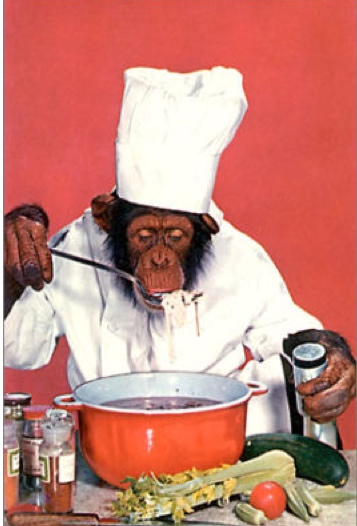As summer winds down, I've been catching up on some old America's Test Kitchen podcasts, including one from June 6 that adds a little monkey business to my earlier musings on Soylent and chewless foods.
In the podcast, Christopher Kimball interviews Harvard primatologist Richard Wrangham about the substance of his 2009 book, Catching Fire: How Cooking Made Us Human. (You can listen to the podcast here; the interview starts at the 16-minute mark.)
I'm not super wise to the latest theories in human evolution, but apparently the conventional argument is that meat-eating is key to explaining the emergence of modern humans. Wrangham argues that the shift to eating meat could not have occurred without cooking. Cooking is what makes the hunter-gatherer lifestyle possible, and all the things that go with it: bigger brains, gendered social structures, culture. A key part of his argument rests on the relationship between cooking and chewing.
Lucy taking a break from chewing, apparently.
According to Wrangham, chimpanzees typically spend six hours a day chewing, and then another couple of hours in a post-prandial lull, digesting. It's not just the actual procurement of food that requires energy, it's the consumption and assimilation of it. All that raw plant matter has to be broken down by time, effort, and big guts. You can see the evidence of this in the anatomy of our plant-eating Australopithecene ancestors (hi, Lucy!): they have great big jaws, big teeth, and big guts.
On the other hand, modern adult humans spend less than an hour a day chewing – a figure that remains consistent, Wrangham says, despite regional, cultural, and economic differences. Unlike our Australopithecene forebears and our living primate relatives, we have relatively small guts, like carnivores, and relatively large and fuel-hungry brains. This anatomical shift is in evidence about two million years ago, with the emergence of another of our ancestors, a species we call Homo erectus.
Homo erectus had small guts, like a carnivore, but did not have sharp carnivore-like teeth to tear meat off bones and consume it raw. Moreover, although meat was important to the Homo erectus diet, it would not have been consistently available year-round. But if Homo erectus meals varied seasonally between being meat-dominant and plant dominant, their small guts and small jaws would not have been sufficient to the task of effectively extracting a sustainable number of calories from plant matter.
Wrangham argues that cooking resolves these puzzles. Cooking changes the material and chemical properties of food, which has two evolutionary advantages: it makes food softer, meaning that less time needs to be spent chewing and digesting, and it denatures proteins and breaks apart chemical bonds, making more calories and nutrients biologically available.
The days of our lives are numbered, as are the hours in each day. Less time spent chewing leaves "more time for other things – going to war, gamboling under a tree, writing poetry."
To illustrate the increased caloric payload of cooked food, Wrangham describes an experiment with rats. One group of rats was fed hard pellets, the other group was fed the same pellets that had been aerated to make them soft and tender. Both groups of rats technically ate the same number of calories, but the rats eating soft pellets had 30 to 40 percent more body fat. (The correlation between softer foods and bigger bodies has also been observed in humans, and is cited as one of the possible explanations for increasing levels of obesity in the developed world.)
Cooking was essential to the emergence of hunter-gatherer cultures because it indemnified against the inherent risks of hunting. Chimpanzees "love meat," Wrangham says, but rarely eat it, and only spend about twenty minutes a day hunting. Why? Because if they go out hunting all day, and fail, there is no way to make up that day's caloric deficit – there aren't enough hours in the day to hunt, fail, and chew leaves for six hours. Cooking meant that humans (men, according to this theory) could venture out and hunt all day, and even if they failed, they would still be able to consume and assimilate enough calories (dished out by women, or whoever else stayed near home base) to make up for the loss.
For Wrangham, cooking is not only key to understanding the evolutionary history of the human species, it is also a uniquely human technology: harnessing external energy sources to improve and enhance the energy-providing qualities of food. Instead of using only our own biological, bodily resources and processes (chewing, digesting) to extract the energy and nutrients from food, cooking takes over some of the work that our hominid ancestors did with their gnashing teeth and their churning guts.
So perhaps chewless foods – like Soylent, or like those Hugo Gernsbach imagined in Ralph – are a brave new stage in evolutionary history, and perhaps our descendants will only use their dainty teeth as ornaments and mementos of a chewier, tougher to swallow, past.

